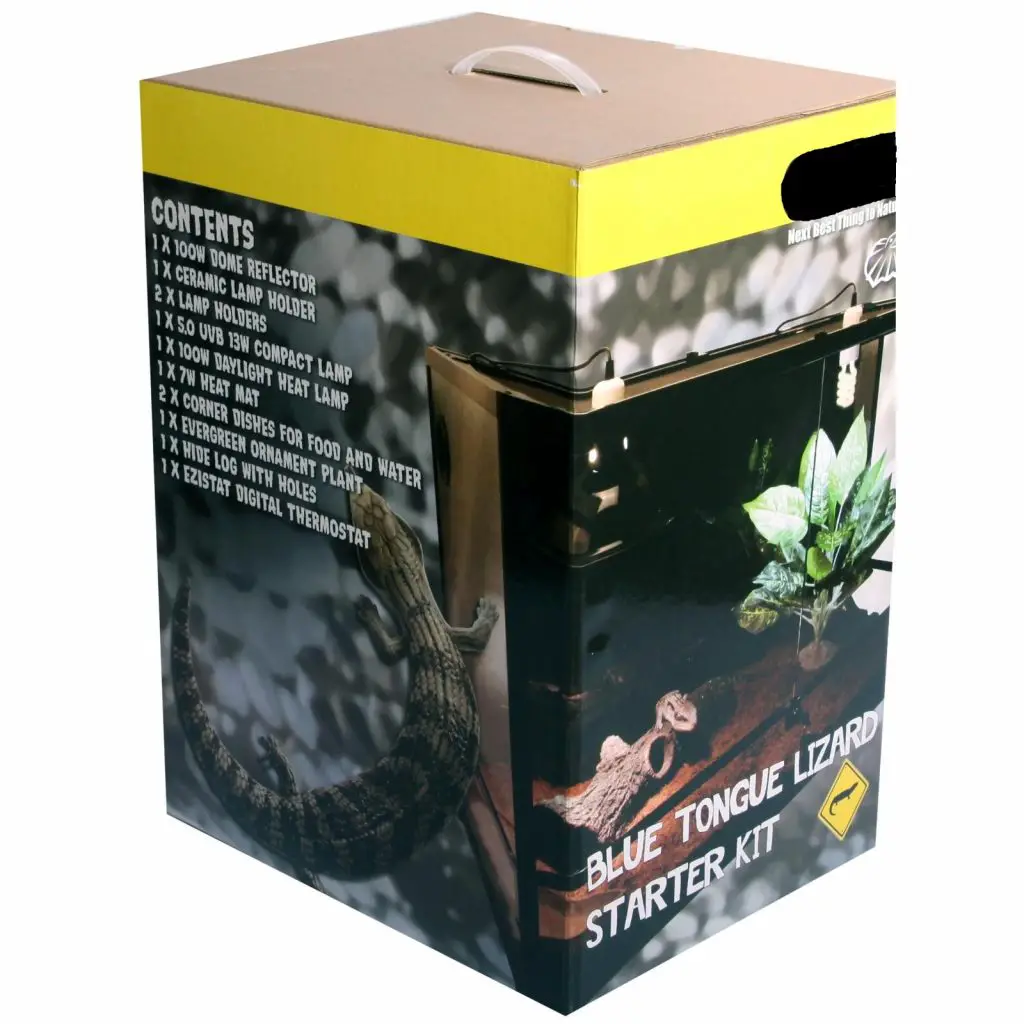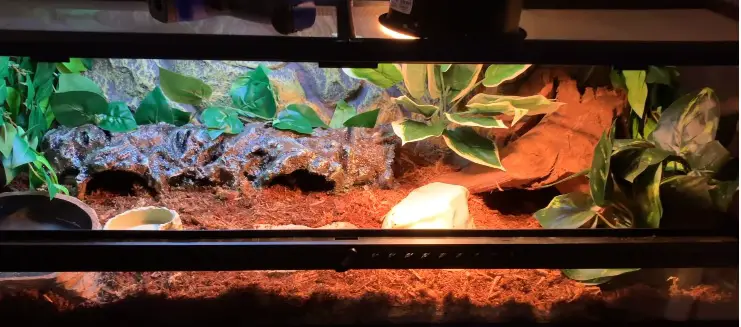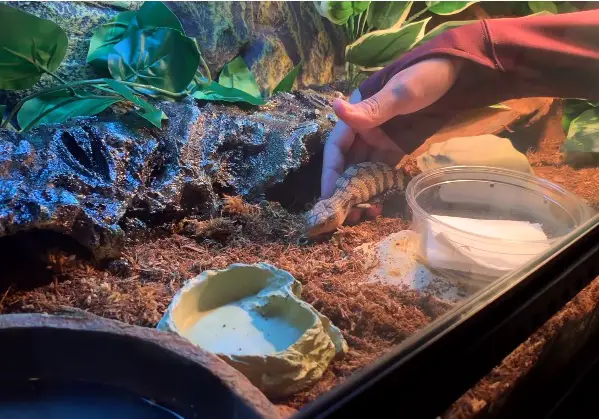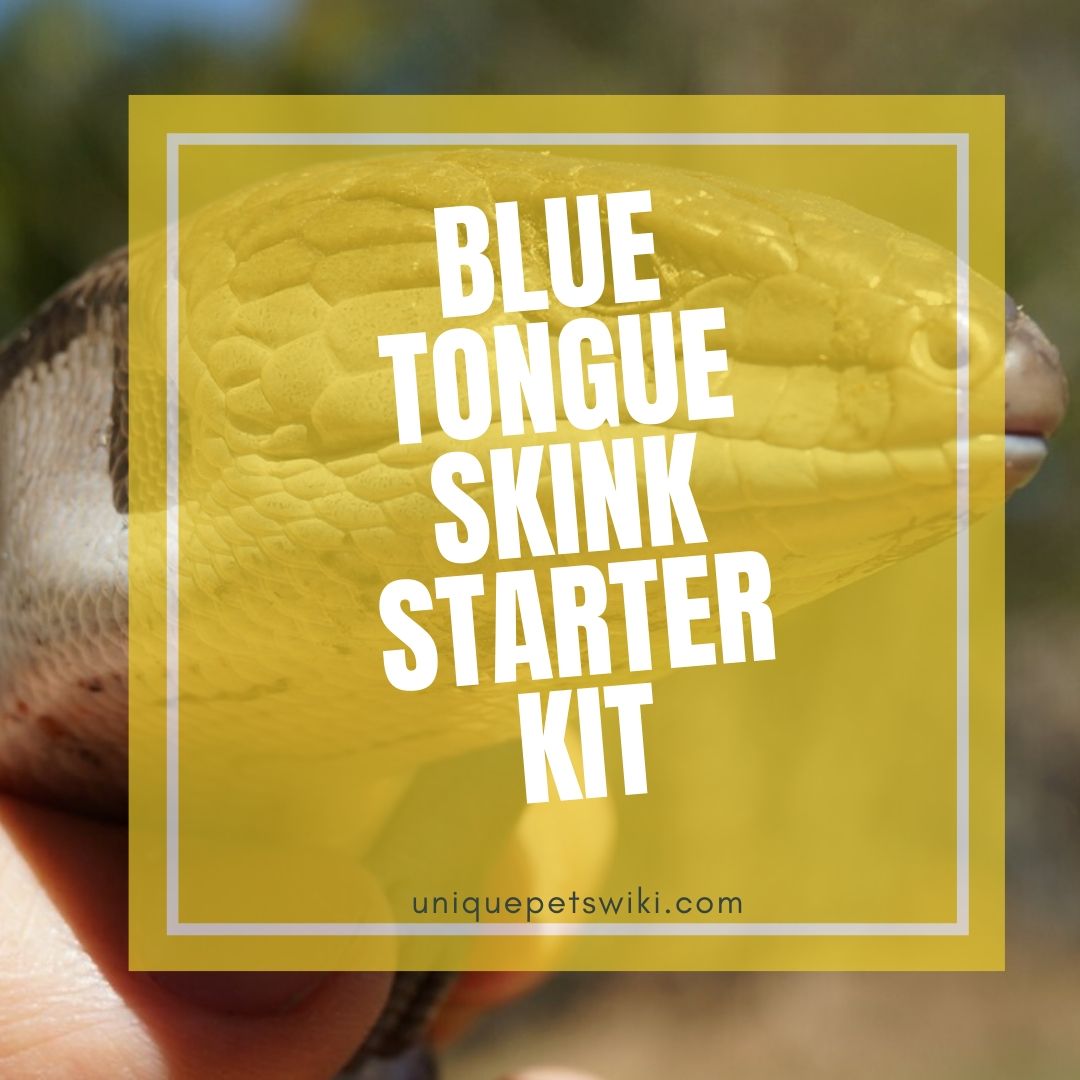As a blue tongue skink beginner, you want everything to be perfect. You are scared to miss one essential item that your blue tongue skink might require. To make everything perfect, you must buy a starter kit for your blue tongue skink, right? After all, it contains everything that your blue tongue skink needs….
Boom! You are wrong!
A blue tongue starter kit could be your worst nightmare. What if the items included in the package do not meet the requirements of your pet?
Keep reading this article to discover why a blue tongue skink is a total complete waste of $$$.
Contents
Why You Should Never Buy a Blue Tongue Skink Starter Kit

Lately, you have been thinking of keeping a blue tongue skink. But, being a beginner, you are nervous and afraid of making any mistake. Well, don’t worry, that’s how every beginner feels.
You must be thinking that buying a starter kit for your blue tongue skink is best. Besides, a starter kit must include everything a blue tongue skink requires.
I am sorry to disappoint you, but you could be wrong. Yes, a blue tongue skink starter kit contains everything that a BTS requires to begin. But, does everything meet the required standard for a BTS? No, they don’t.
Keep reading to understand why I say a blue tongue skink starter kit is a throw!
Reason #1: They Feature a Small Tank Size
After a few months of purchasing your starter kit, then boom! It’s too small for the growing BTS. I can imagine the disappointment.
Most starter kits come with 20-40 gallons tanks. Thus, they are only suitable for baby and juvenile blue tongue skinks. The minimum size of adult blue tongue skinks should be 55 gallons.
On the other side, a 20-gallon tank is only suitable for a baby blue tongue skink. Therefore, if you start with a 20-gallon tank, you will have to upgrade to a bigger tank soon.
Remember that setting up a tank for your blue tongue skink is the first step before bringing in your pet. Thus, you need to do proper research on the blue tongue skink requirements before you commit.
Also, it is necessary to understand that blue tongue skinks are not good climbers. Therefore, their tank should be long enough for them to move around comfortably. The best tanks for blue tongue skinks should be at least twice as long as they are.
Reason #2: Their UVB Bulbs are Too Small
Whether a beginner or an experienced blue tongue skink owner, you have probably done your research on UVB bulbs. Just in case you skipped the step, here is a quick recap;
- Blue tongue skinks being basking animals, they require a strong UVB bulb
- The UVB bulb should be at least 10-12% and should cover at least 2/3 of the enclosure’s length.
- A blue tongue skink requires both UVB and UVA.
A UVB bulb for a blue tongue skink is critical. Thus it must be strong enough to supply the required vitamins for your blue tongue skink.
Lack of Vitamin D3 can cause a metabolic disease in blue tongue skinks. It’s one of the common health problems that blue tongue skinks encounter in captivity.
The UVB bulbs that feature in blue tongue skink starter kits are weak. Thus, they do not provide enough Vitamin D3 for your skink.
Also, it is worth noting that those starter kits bulbs are fluorescent compact and thus not recommended for blue tongue skinks. Fluorescent, compact bulbs can harm blue tongue skink’s eyes.
Reason #3: They Often Use Colored Bulbs
A colored bulb for blue tongue skink is a bad idea. During the day, bright white lights are the best. Bright white lights stimulate blue tongues skink’s appetite and activity.
Colored bulbs such as red or blue are known to disturb blue tongue skink’s sleep cycle. Therefore, a colored bulb in your blue tongue skink tank is not necessary. It is actually harmful and a complete waste in a blue tongue skink starter kit.
New to blue tongue skink? Check out the blue tongue skink care sheet now! We had listed out all the things you need to know about blue tongue skinks as pets. Check it now!
Reason #5: They Randomly Include A Night Light
Blue tongue skinks are diurnal and thus sleep at night. Therefore, during the night, you can use a ceramic heat-emitting bulb. It is worth noting that ceramic heat will only emit heat and not light at night. Blue tongue skinks do not require light at night.
Also, you can consider using an under tank heating pad instead. However, you need to see that the under tank heater is covering a small part of the tank to avoid overheating.
Therefore, including a night light bulb in a blue tongue starter kit is not necessary at all.
Reason #6: They Provide Dangerous Substrate
Blue tongue skinks are burrowing animals. Thus, it is critical to include substrate or beddings in their tank. However, there are good and bad substrates for blue tongue skinks.
Blue tongue skink starter kit often comes with sand substrate. A sand substrate is inadequate for blue tongue skinks. Other harmful substrates are;
- Reptibark
- Carefresh rodent bedding
- Pine/cedar wood products
These substrates are harmful to blue tongue skinks as they do not meet the required humidity. Low humidity in a blue tongue skink’s beddings poses health issues to them. For these reasons, it is much better if you would not buy a blue tongue starter kit.
Reason #7: They include cheap & Inaccurate Temperatures/Humidity Gauges
If you want a healthy blue tongue skink, you can never negotiate on temperature and humidity. Heat and moisture in a blue tongue skink must be accurate. Thus, you must heavily invest in a good thermometer and hygrometer gauge.
On the other hand, starter kits will provide you with the cheapest options. Therefore, it’s almost impossible for your blue tongue skink to thrive with a starter kit.
Buying a starter kit for your blue tongue skink could be the most comfortable option for beginners. However, you will have to rebuy almost everything that came with the package. Therefore, you should consider doing your research well and buying the best-required items for your blue tongue skink.
Actual Must-Haves for Blue Tongue Skinks Kit

(Source: Elle’s Reptiles YouTube)
By now, you have probably made up your mind that a blue tongue skink starter kit cannot work for you. But, even so, you also know that you have to have your starter kit for your blue tongue skink.
Let us now discuss what you should include in your blue tongue starter kit. If you follow our guide keenly, you will make your blue tongue skink happy and comfortable. And, help them thrive in captivity.
Keep on reading!
Must-Have #1: A Large Tank
Blue tongue skinks can survive in captivity for up to 20 years. Thus, when buying a tank for your blue tongue skink, you should consider:
- The tanks durability
- The tank size
Tank size
I can imagine that you wouldn’t want to keep buying a new tank once your blue tongue skink outgrows the current one. Blue tongue skink tanks are expensive and thus, purchasing a large tank will save you money.
The minimum requirement for a blue tongue skink tank should be 40 gallons. However, the best-recommended size should be 60 gallons.
Remember that one of the reasons we discouraged a blue tongue skink starter kit was the tank size. Thus, buying a large tank for your pet will give them enough room to move around.
Blue tongue skinks are durable and can serve your pet for the rest of their lives. Thus, you can initially buy a large tank even if you are only purchasing a baby blue tongue skin.
If a blue tongue skink requires a tank that is at least two times long that it is, how long should their tank be?
If an adult blue tongue skink can grow up to 20″ long, thus, the tank must be at least 40″ long.
See here some of the best tanks for a blue tongue skink
Last update on 2022-12-30 / Affiliate links / Images from Amazon Product Advertising API
Must-Have # 2: A bright White Incandescent or Halogen Bulb
Probably the best thing to remember is that your blue tongue skink requires a bright white incandescent bulb. The bulb is almost similar to the one you use in your house. Therefore, you don’t have to go overboard trying to get the most expensive bulb for your pet.
The bulbs are probably the cheapest component that your blue tongue skink requires. However, most reptile pet beginners make a mistake of trying to go fancy with the bulbs, and they end up messing instead.
See extra tips on setting up your light bulbs:
• The UVB light must be mounted from above and not on the side
• To prevent eye damage, place the UVB tube light behind the basking bulb.
• Place the UVB tube near the basking bulb.
The best bulbs to use for your blue tongue skinks are
• Halogen floodlights
•Incandescent bright white bulbs
These bulbs are the best because they provide enough light for your blue tongue skink during the day. However, you should turn off the light at night, and as we said earlier, don’t use coloured bulbs.
Last update on 2022-12-30 / Affiliate links / Images from Amazon Product Advertising API
Must-Have #3 A trusted UVB Bulb or Mercury Vapor Bulb
A blue tongue skink CANNOT survive without UVB light. In the wild, they bask a lot. Thus, in captivity, UVB light is essential for providing them with vitamin D3.
Vitamin D3 is essential for absorbing calcium. Deficiency in vitamin D3 causes a metabolic disease in blue tongue skinks.
It would be best if you would use a tube light rather than a light bulb. It is because the best UVB light should occupy 50-70% of the tank’s length.
Also, you should note that if the UVB light is too close to your blue tongue skink, it can damage or irritate his eyes. Again, it might not be of any benefit if you place it too far. Therefore, you should be able to balance the distance well for the best results.
Inadequate heating and basking light options
- Any bulb that burns out quickly like a spotlight
- Any bulb that can overheat and burn soon like heat rocks
- Any bulb that produces colour
Last update on 2022-12-30 / Affiliate links / Images from Amazon Product Advertising API
Must-have #4: A reliable Thermometer & Hygrometer
Like I said before, temperature and humidity are two vital components for a blue tongue skink. You can not guess or imagine the best heat for your blue tongue skinks. Too much moisture can cause respiratory health issues for blue tongue skinks and so can too low humidity.
New to blue tongue skink? Check out the blue tongue skink care sheet now! We had listed out all the things you need to know about blue tongue skinks as pets. Check it now!
Blue tongue skinks are cold-blooded animals. Thus, you must provide them with adequate ambient temperature.
Therefore, investing in a good thermometer and hygrometer will come in handy. The good news is, you can get a cheaper gauge but, you will have to wait longer to see the results.
However, if you are willing to invest in a little more, you can get an actual thermometer gun that will give you instant results.
Even so, there are far plenty of reliable and trusted thermometers that can work wonders for your blue tongue skinks.
Last update on 2022-12-30 / Affiliate links / Images from Amazon Product Advertising API
Must-Have #5: Non-particle Based Substrate
Choosing the best substrate for your burrowing pet is critical. The substrate must be 4-6 inches deep. Also, it should be soft and loose. However, your blue tongue skink type will determine the kind of substrate to use.
Australian Blue tongue skink
For Australian blue tongue skinks, you can use:
- Reptichip
- Lugarti Natural Reptile Bedding
- Semi-arid DIY mix: 60% top organic soil and 40% play sand
Indonesian blue tongue skinks
- Sphagnum moss
- Reptichip
- Sugar Cane mulch
- Humid DIY mix: 40% Zoo med Repti Soil+ 40% organic topsoil 20% play sand.
Bioactive substrate
The bioactive substrate is probably the best for both Australian and Indonesian blue tongue skinks. They are self-sustaining. Thus, the bioactive substrate must contain two or more components, and it has layers.
For example, a humid bioactive substrate can include cypress mulch, untreated topsoil, leaf litter and moss.
The best part of the bioactive substrate is that you don’t have to clean it up. All you have to do is wipe off the glass, pick up large pieces of waste, and you are done. It contains bugs that do the work for you. The bugs clean up faeces, uneaten food, and fallen leaves.
On the other hand, the blue tongue skinks dig up the bugs and make snacks out of them. Thus, the bioactive substrate is not only suitable for maintaining humidity, but also they are right for your blue tongue skink snacks.
The bioactive substrate is expensive to set up. But, it is cheap to maintain and thus, it saves more money in the long run.
Last update on 2022-12-30 / Affiliate links / Images from Amazon Product Advertising API
Recommended accessory: Safe Plants & Décor
Now you have everything you need to set up your blue tongue skink tank. The last and also essential component for a blue tongue skink tank is the décor and accessories.
Let’s first see blue tongue skink accessories list
- Food bowl
- Water dish
- Branches, logs
- Hides
- Tank background
- Basking rock
Water dish
Blue tongue skinks do not only need a water bowl to drink from but also to soak. They love soaking in the water but they are not good swimmers. Thus, the dish should not be too deep, or they might drown. The ideal bowl should be 2-3 inches deep.
Food bowl
The food bowl can be medium-size or large. Some pet keepers prefer getting separate bowls for slow-moving bugs. And, another with tall sides to prevent fast-moving worms from escaping.
You should remove any uneaten food immediately to avoid bacterial infections. Also, thoroughly wash the bowl with soap and water, and occasionally disinfect water dishes.
Basking rock
Just like in the wild, it is critical to include a basking rock in your blue tongue skink tank. The stone will motivate the blue tongue skink to bask. Also, it will help the blue tongue skink to rise above the ground and get closer to the heat lamp.
The size of the rock practically depends on the size of the blue tongue skink. Provide a big stone for adults and a small rock for juvenile and baby blue tongue skinks. The stone should be comfortable enough for the lizard when laying on it.
Do You Need Branches?
Blue tongue skinks have short legs, and thus, they are poor climbers. However, they enjoy climbing on small structures. Therefore, getting an extensive log or a branch is essential for them to climb on and hide.
Plants and foliage
It’s okay to include live plants in a blue tongue skink tank. However, it is not the best option. Blue tongue skinks like to burrow, and thus they are highly likely to damage the plants.
The best types of plants to include in their tanks are artificial vines and foliage. The best branches are Mopani wood, driftwood and grape wood.
Hides
Blue tongue skinks are naturally hiding creatures. Thus, hide is a must component in their tank. Therefore, you should include at least two hides for your blue tongue skink.
Tank background
Tank background is also crucial to add in a blue tongue skink tank. It’s usually a realistic sticker that you stick on the bank of the tank.
Wrapping up Blue Tongue Skink Starter Kit

(Source: Elle’s Reptiles YouTube)
At this point, you probably now understand why we think that blue tongue skink starter kit is a throw.
It is far much better if you would get your starter up kit for your blue tongue skink. This way, you will not only be confident about the setup components, but you will also save more in the future.
It might not be easy, especially if you are on a tight budget but, the good news is, if you do it right in the beginning, it will be cheaper in the end.















